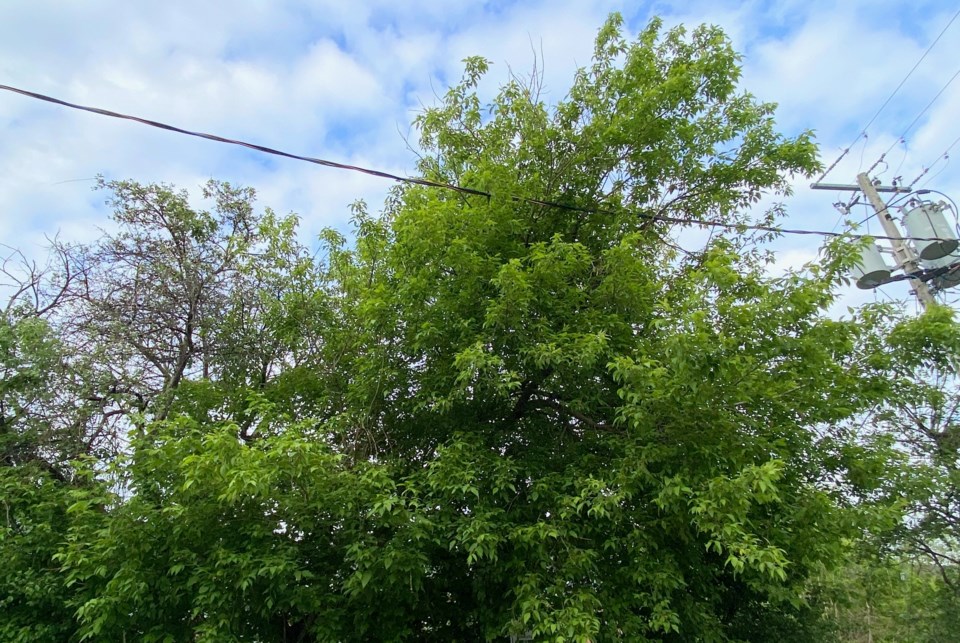Council committee is bowing to public pressure when it comes to the city’s proposed tree preservation bylaw.
City staff and the environmental advisory committee (EAC) previously recommended the bylaw regulate tree removal on properties of any size. The existing bylaw applied only to properties larger than half a hectare, or about 1.25 acres.
That recommended change did not go over well with members of the public. Of the approximately 400 people who provided input, more than 80 per cent were not in favour of regulating tree removal on properties of all sizes. So, staff and the EAC met again and asked council committee Monday to stick with the status quo regarding property sizes.
Council members supported that recommendation, including Coun. Jay Fallis, though he had some reservations. He wanted to see the bylaw apply to properties smaller than half a hectare as long as exceptions could be made for dead and dying trees and those that pose a risk to structures.
“We kind of lost an opportunity to apply this to properties that are under the half-hectare size,” he said.
“As a property owner, I understand that it is very frustrating that this potential bylaw could leave me with a significant cost,” he continued, but added he was concerned about what it could mean for future generations and that the bylaw is meant to apply to those who don’t tend to respect the “environmental implications” of removing trees.
Also included in the bylaw are more expensive fines the city can impose, a move meant to act as a deterrent to those considering removing or damaging healthy trees.
The existing bylaw allows for a maximum fine of $5,000. The proposed bylaw calls for that maximum to be increased to $10,000 on a first offence or $1,000 per tree, whichever is greater, “to give us a bit more teeth, so to speak,” said Shawn Crawford, manager of legislative services.
The bylaw approved Monday stipulates that if a tree is 25 centimetres/10 inches or more in diameter at breast height (four-and-a-half feet), a property owner must have a certified arborist assess the tree to determine its risk to people or property before the tree could be removed.
It also states if a tree is deemed to be dying or diseased, posing a risk to people or property, the owner can have it removed without a permit but would first need to notify the city and provide the arborist’s report or a quote from the arborist.
If a tree is deemed to be healthy and the property owner still wants to have it removed, a $250 permit from the city would be required. In that case, the owner would be required to plant a replacement tree or pay a $350 fee that would go toward the city’s tree-planting program.
Related motions passed by council committee include directing the EAC to submit a 2022 capital budget request “for the development and implementation of a public education program for tree conservation and care.”
Staff and the EAC will also prepare a submission to go to budget committee in 2023 that will look at creating a new tree canopy study. There has been only one such study in Orillia, and it happened in 2018.
That step was welcomed by Coun. Tim Lauer, who noted many residents suggested the city look at how it deals with trees on municipal property before asking more of the public.
“We need to look inward, look at what we’re doing as a city in regards to trees,” he said, adding an updated canopy study would help.
Lauer did take issue with a list of trees that would be exempt from the new bylaw. They are common buckthorn, European buckthorn, English hawthorn, Manitoba maple, Norway maple, silver poplar, and willow. He asked how staff and the EAC landed on those species to be exempt.
Crawford said staff heard from some people who wanted certain trees that are invasive be exempt from bylaw. Staff also looked at other municipalities to see what trees they were exempting. Some included these trees on their list, and some had up to 20 species that were exempt.
He noted the trees recommended for exemption in Orillia include a mix of invasive species and those that tend to cause problems in an urban environment.
Council committee supported Lauer’s request that the list of exemptions be removed from the bylaw and forwarded to the EAC for further discussion.
Finally, council committee directed staff to look into potential partnerships with either Lakehead University or the University of Toronto “for the purpose of preparing an urban forest management strategy and plan, and submit a 2024 capital budget request.”
Coun. Mason Ainsworth asked if the city was limiting itself by only considering those two universities.
EAC chair Michael Williams pointed out both are “renowned for their forestry programs.”
Williams also described the urban forestry management strategy and plan as “the most important part of the recommendation going forward.”
Many municipalities have completed similar strategies, “and there’s a great payoff,” he said, noting they help with data collection and setting targets for tree canopies.
“This is the kingpin of going forward,” he said.
Council committee’s decisions will be up for ratification at next week’s council meeting.
